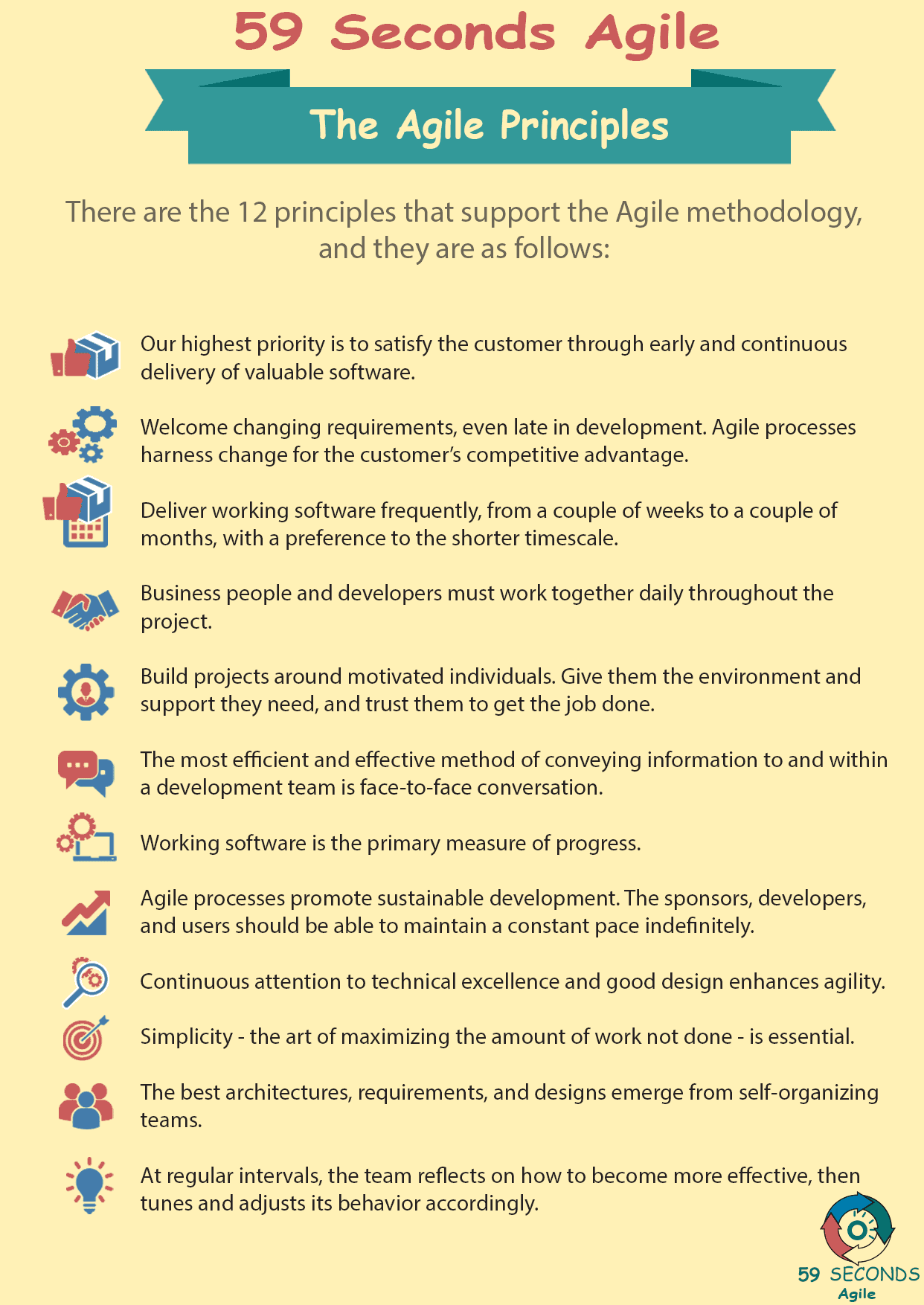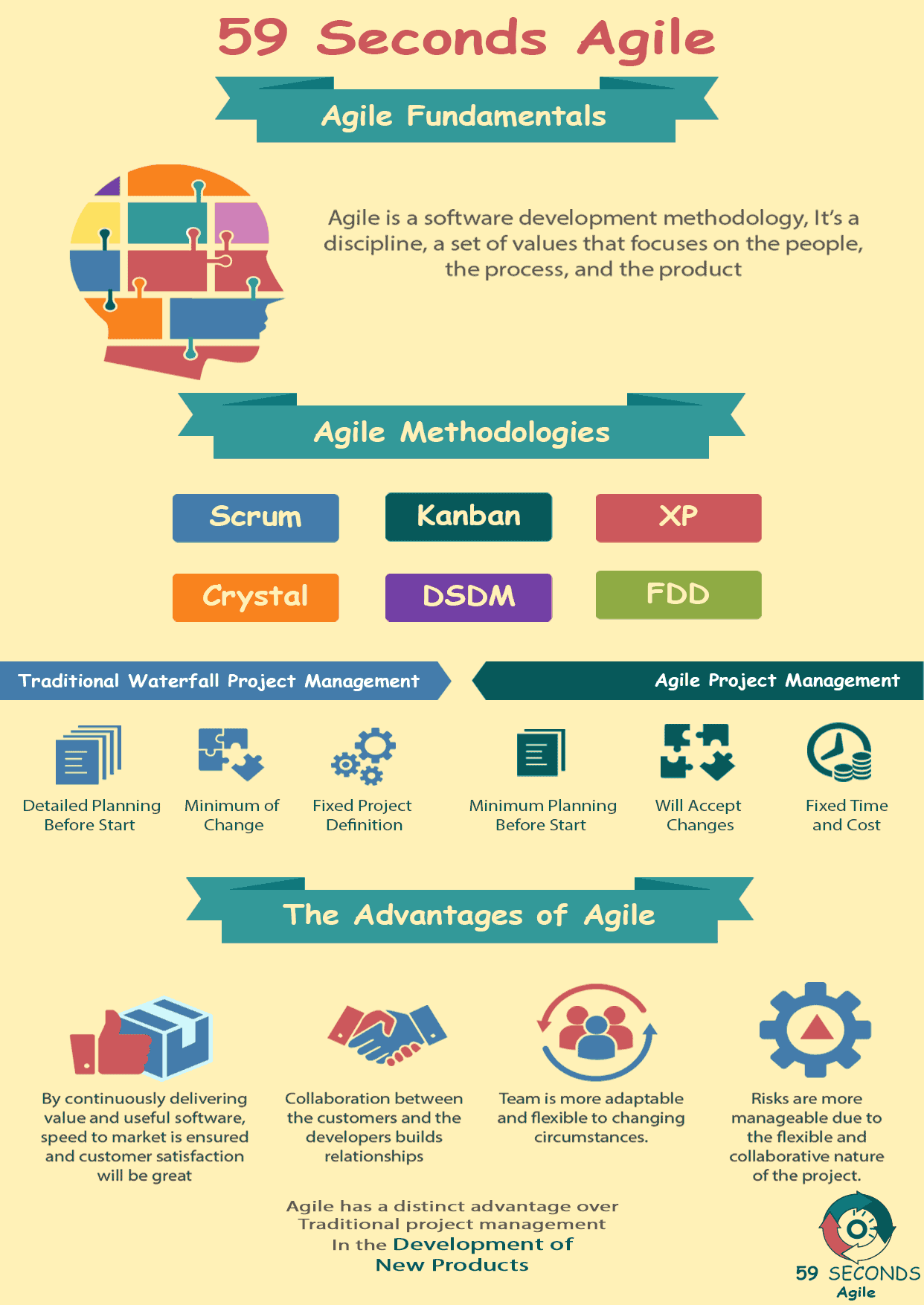This article looks to discuss the 12 Principles of Agile, and discussed them in relation to the Scrum Product Owner role. The article discusses the history of Agile before moving on to discuss the details of each of the 12 Agile Principles and relates each of them to the Product Owner.
The Agile Fundamentals
A 59 Seconds Agile Video Animation
The 12 Principles of Agile and the Product Owner
A 59 Seconds Agile Article
Agile software development – or Agile – is a collection of software development values and principles that emphasizes adaptive planning, continuous improvement, evolutionary progress and encourages quick, flexible response to change.
In theory, if you are a product owner, your responsibilities within the agile framework are simple: “maximize the value of the product and the work of the Development Team”. In reality, product owners do more than just that. They bridge the gap between what a customer wants, stakeholder’s interests and the development team’s work on the project. A product owner needs to understand a customer’s needs in the context of the market it is in, as well as the needs of the development team and stakeholders. Applying the 12 principles of Agile to project management brings a team back to basics and helps product owners fulfill their role.

Agile History and The 12 Principles of Agile
During a meeting of 17 software developers in Utah, the Agile Manifesto was born out of a need to change the way software development took place. The manifesto developed is comprised of 12 principles and each of these principles makes up the foundation of the agile movement we use today. Its emphasis on lean manufacturing, communication, collaboration, flexibility, and customer focus has lead other industries to utilize its principles to manage projects and increase production.

The 12 Principles of Agile: Principle 1
1. Our highest priority is to satisfy the customer through the early and continuous delivery of valuable software.
Customers are happier when they don’t have to wait long periods of time for a working product. They have problems that need solutions, that is why they are having you do something for them. By understanding what the customer’s needs are, a Product Owner can keep customers happy by shortening the time between gathering requirements and feedback. As a Product Owner, this allows for more opportunities to steer the product in a direction that is agreeable to the customer.
The 12 Principles of Agile: Principle 2
2. Welcome changing requirements, even late in development. Agile processes harness change for the customer’s competitive advantage.
Needs often change during the course product development. When inevitable changes come about, implement them as soon as possible by shortening the time between when a change is conceived and when it is implemented. As a product owner, ensuring that changes are implemented right away – and not when the next system redesign comes about or next system is built – is important to keep the needs of all those involved in the forefront.
Our Favourite Agile Books
We found these books great for finding out more information on Agile Scrum:
The 12 Principles of Agile: Principle 3
3. Deliver working software frequently, from a couple of weeks to a couple of months, with a preference to the shorter timescale.
Previous project development approaches were usually front-loaded. They often required 100% of the requirements and documentation to be completed before starting a project. This was time-consuming and didn’t allow for a lot of change.
On the other hand, Agile focuses on shortening the distance between planning and delivery. All the requirements aren’t required to begin work. Instead, it is a working process that focuses on creating the product, not just planning for it.
The 12 Principles of Agile: Principle 4
4. Business people and developers must work together daily throughout the project.
Collaboration between business stakeholders and the development team should be done throughout the whole project. Ensuring this collaboration and communication takes place is crucial. Communication tools can be used to ensure this collaboration takes place and helps the two sides understand each other better. This leads to more productive, effective work.
Prev <— Continue Reading —> Next
User Stories Applied
A 59 Seconds Agile Book Review
User Stories Applied by Mike Cohn is one of our favourite books on Agile User Stories. The book starts with an overview into user stories, and details what a user story is and the different aspects of them. He then discusses how to go about writing a user story, and provides details of the INVEST criteria that can be used to determine if the story is meeting all of its objectives. Next Mike gives an in depth discussion of who user stories are written for and where to begin when gathering the details for them. The book then discusses acceptance testing user stories, including how to go about specifying these criteria and the responsibilities of the development team and customers during this process.
Prev <— Continue Reading —> Next
Learn More
Agile Project Management Training Courses
Agile Fundamentals
A 59 Seconds Agile Infographic


